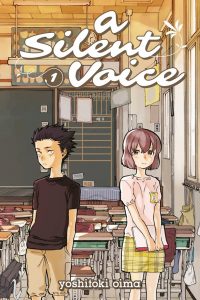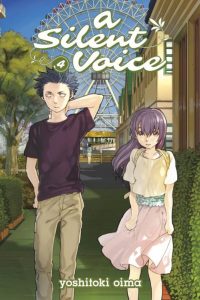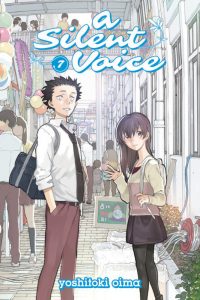By Yoshitoki Oima | Published by Kodansha Comics
 In elementary school, Shoya Ishida often engaged in foolhardy stunts to stave off boredom. When hearing impaired transfer student Shoko Nishimiya joins his class and causes disruption within the class, she becomes Shoya’s target. Initially, the other kids laugh at Shoya’s antics but when he goes too far and destroys several hearing aids to the tune of $14,000, they swiftly condemn him. Now he’s the one who’s ostracized and this status continues into high school, long after Shoko transferred out again. Full of self-loathing, he’s preparing to commit suicide, but a chance reunion with Shoko inspires him to try to change.
In elementary school, Shoya Ishida often engaged in foolhardy stunts to stave off boredom. When hearing impaired transfer student Shoko Nishimiya joins his class and causes disruption within the class, she becomes Shoya’s target. Initially, the other kids laugh at Shoya’s antics but when he goes too far and destroys several hearing aids to the tune of $14,000, they swiftly condemn him. Now he’s the one who’s ostracized and this status continues into high school, long after Shoko transferred out again. Full of self-loathing, he’s preparing to commit suicide, but a chance reunion with Shoko inspires him to try to change.
One of the first things Shoya does is accept the friendship of a tubby, pushy classmate called Tomohiro Nagatsuka. Tomohiro doesn’t have much depth or subtlety as a character, but he proves to be a reasonably faithful friend and helps Shoya become more sociable. Soon, he meets Yuzuru, Shoko’s tomboyish sister, and reunites with more girls from his elementary school class. Many of the middle volumes involve frictions between this group of people, particularly between a volatile girl named Naoka and Shoko. Shoya tries to help patch their relationship, but things do not go well at all. There is a lot of punching and hair-pulling, in fact.
 Back and forth things go, with this group continuing to try to establish themselves as friends without seeming to genuinely like each other much. Eventually, they decide to film a movie together. For one scene, they need to acquire permission to film at their old elementary school. Shoya is the unwilling emissary, and an encounter with his odious former teacher leaves him feeling so awful about himself that he ends up lashing out at all his friends, seemingly trying to drive them away as he feels he deserves. This has the unintended side effect of causing Shoko to feel like she’s the cause of his unhappiness, prompting a desperate act.
Back and forth things go, with this group continuing to try to establish themselves as friends without seeming to genuinely like each other much. Eventually, they decide to film a movie together. For one scene, they need to acquire permission to film at their old elementary school. Shoya is the unwilling emissary, and an encounter with his odious former teacher leaves him feeling so awful about himself that he ends up lashing out at all his friends, seemingly trying to drive them away as he feels he deserves. This has the unintended side effect of causing Shoko to feel like she’s the cause of his unhappiness, prompting a desperate act.
Throughout, I enjoyed Shoya’s arc. I like that gaining some people to hang out with is not enough to immediately banish self-hatred or prevent negative feelings. Only at the end of the series does Shoya gain the courage to face people honestly, accepting criticism for his faults and misdeeds while also being open to the possibility that not everyone is hostile towards him. I do wish we got more emphasis on Shoko’s inner life, however, even though I liked the direction she’s headed at the end of the series.
 Less clear is what Oima was aiming for with their group of friends. Even though Naoka was far more outwardly nasty to Shoko, at least she was open about it and expressed a great deal of self-loathing because of her behavior. With the help of another friend, Miyoko, she is encouraged to have a bit more optimism, and will probably end up doing okay. Even though she could’ve been fleshed out further, I do like Naoka as a character. But man oh man, do I hate Miki. She makes everything about herself—at one point revising the bullying narrative so that she and Shoko were co-victims—and doesn’t seem to grow at all. Everything she does seems fake, because most of it is, and I was baffled when the boy she fancies declared her to be “kind” after some weepy episode. Miki should get hit by a bus.
Less clear is what Oima was aiming for with their group of friends. Even though Naoka was far more outwardly nasty to Shoko, at least she was open about it and expressed a great deal of self-loathing because of her behavior. With the help of another friend, Miyoko, she is encouraged to have a bit more optimism, and will probably end up doing okay. Even though she could’ve been fleshed out further, I do like Naoka as a character. But man oh man, do I hate Miki. She makes everything about herself—at one point revising the bullying narrative so that she and Shoko were co-victims—and doesn’t seem to grow at all. Everything she does seems fake, because most of it is, and I was baffled when the boy she fancies declared her to be “kind” after some weepy episode. Miki should get hit by a bus.
Lastly, there were some thoughtful depictions of how characters perceive the spoken word. In later volume there’s a chapter from Shoko’s point of view where all of the dialogue in the speech bubbles is only about sixty percent legible. It’s a neat effect. Too, on several occasions Shoya seems to overhear his classmates making derogatory comments about him. The scenes are depicted in such a way that the reader has doubt—is he just imagining what they’re saying, or are they really saying it? This struggle to interpret conversation is something he and Shoko have in common.
Despite a couple of complaints, I’d say A Silent Voice is well worth reading!
A Silent Voice is complete in seven volumes, all of which are now available in English.




Speak Your Mind